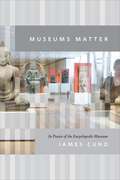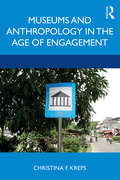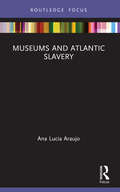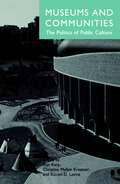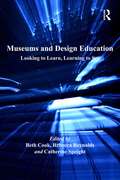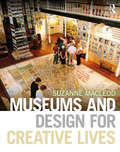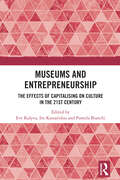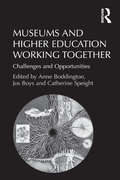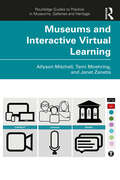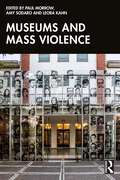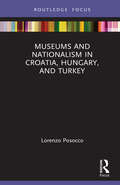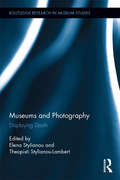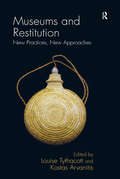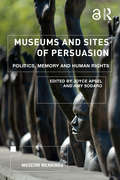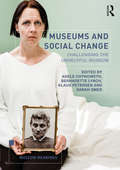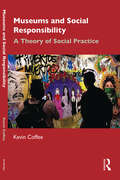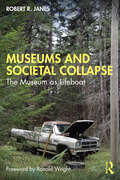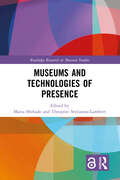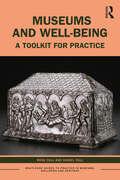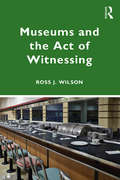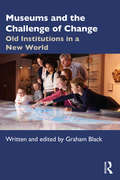- Table View
- List View
Museums Matter: In Praise of the Encyclopedic Museum (The Rice University Campbell Lectures)
by James CunoThe concept of an encyclopedic museum was born of the Enlightenment, a manifestation of society’s growing belief that the spread of knowledge and the promotion of intellectual inquiry were crucial to human development and the future of a rational society. But in recent years, museums have been under attack, with critics arguing that they are little more than relics and promoters of imperialism. Could it be that the encyclopedic museum has outlived its usefulness? With Museums Matter, James Cuno, president and director of the Art Institute of Chicago, replies with a resounding “No!” He takes us on a brief tour of the modern museum, from the creation of the British Museum—the archetypal encyclopedic collection—to the present, when major museums host millions of visitors annually and play a major role in the cultural lives of their cities. Along the way, Cuno acknowledges the legitimate questions about the role of museums in nation-building and imperialism, but he argues strenuously that even a truly national museum like the Louvre can’t help but open visitors’ eyes and minds to the wide diversity of world cultures and the stunning art that is our common heritage. Engaging with thinkers such as Edward Said and Martha Nussbaum, and drawing on examples from the politics of India to the destruction of the Bramiyan Buddhas to the history of trade and travel, Cuno makes a case for the encyclopedic museum as a truly cosmopolitan institution, promoting tolerance, understanding, and a shared sense of history—values that are essential in our ever more globalized age. Powerful, passionate, and to the point, Museums Matter is the product of a lifetime of working in and thinking about museums; no museumgoer should miss it.
Museums and Anthropology in the Age of Engagement
by Christina KrepsMuseums and Anthropology in the Age of Engagement considers changes that have been taking place in museum anthropology as it has been responding to pressures to be more socially relevant, useful, and accountable to diverse communities. Based on the author’s own research and applied work over the past 30 years, the book gives examples of the wide-ranging work being carried out today in museum anthropology as both an academic, scholarly field and variety of applied, public anthropology. While it examines major trends that characterize our current "age of engagement," the book also critically examines the public role of museums and anthropology in colonial and postcolonial contexts, namely in the US, the Netherlands, and Indonesia. Throughout the book, Kreps questions what purposes and interests museums and anthropology serve in these different times and places. Museums and Anthropology in the Age of Engagement is a valuable resource for readers interested in an historical and comparative study of museums and anthropology, and the forms engagement has taken. It should be especially useful to students and instructors looking for a text that provides in one volume a history of museum anthropology and methods for doing critical, reflexive museum ethnography and collaborative work.
Museums and Atlantic Slavery (Museums in Focus)
by Ana Lucia AraujoMuseums and Atlantic Slavery explores how slavery, the Atlantic slave trade, and enslaved people are represented through words, visual images, artifacts, and audiovisual materials in museums in Europe and the Americas. Divided into four chapters, the book addresses four recurrent themes: wealth and luxury; victimhood and victimization; resistance and rebellion; and resilience and achievement. Considering the roles of various social actors who have contributed to the introduction of slavery in the museum in the last thirty years, the analysis draws on selected exhibitions, and institutions entirely dedicated to slavery, as well as national, community, plantation, and house museums in the United States, England, France, and Brazil. Engaging with literature from a range of disciplines, including history, anthropology, sociology, art history, tourism and museum studies, Araujo provides an overview of a topic that has not yet been adequately discussed and analysed within the museum studies field. Museums and Atlantic Slavery encourages scholars, students, and museum professionals to critically engage with representations of slavery in museums. The book will help readers to recognize how depictions of human bondage in museums and exhibitions often fail to challenge racism and white supremacy inherited from the period of slavery.
Museums and Communities: The Politics of Public Culture
by Ivan Karp Steven Levine Christine Mullen KreamerContributors to this volume examine and illustrate struggles and collaborations among museums, festivals, tourism, and historic preservation projects and the communities they represent and serve. Essays include the role of museums in civil society, the history of African-American collections, and experiments with museum-community dialogue about the design of a multicultural society.
Museums and Design Education: Looking to Learn, Learning to See
by Rebecca ReynoldsHow can museum educators and higher education tutors enhance the way HE students use museums? There are many examples in the UK of museums and universities working together in productive and innovative ways, but these relationships tend to be based on individual enthusiasm and opportunistic arrangements. Despite the growing importance of museum education departments, higher education tends to be overlooked by museums. This book looks at the interaction between design students and museums, and explores issues, projects and emerging ideas about how museums can better support HE students. It illustrates the general lessons that can be learnt, both strategic and practical, which can help to bring about long-term and constructive relationships between museums and universities in order to enable effective student learning.
Museums and Design for Creative Lives
by Suzanne MacLeodMuseums and Design for Creative Lives questions what we sacrifice when we allow economic imperatives to shape public museums, whilst also considering the implications of these new museum realities. It also asks: how might we instead design for creative lives? Drawing together 28 case studies of museum design spanning 70 years, the book explores the spatial and social forms that comprise these successful examples, as well as the design methodologies through which they were produced. Re-activating a well-trodden history of progressive museum design and raising awareness of the involvement of the built forms in how we feel, think and act, MacLeod provides strategies and methods to actively counter the economisation of museums and a call to museum makers to work beyond the economic and advance this deeply human history of museum making. Museums and Design for Creative Lives will be of great interest to academics and students in museum studies, gallery studies, heritage studies, arts management, communication and architecture and design departments, as well as those interested in understanding more about design as a resource in museums. The book provides a valuable resource for museum leaders and practitioners.
Museums and Entrepreneurship: The Effects of Capitalising on Culture in the 21st Century
by Eve Kalyva Pamela Bianchi Iro KatsaridouMuseums and Entrepreneurship: The Effects of Capitalising on Culture in the 21st Century addresses the largely under-examined impact that different entrepreneurial endeavours have on museum practices today.It identifies an entrepreneurial turn in today’s neoliberal context and critically evaluates how this turn redefines museums in organisational, conceptual and empirical terms. It assesses the challenges that different types of museums face, examining how they are conceptualised, managed and experienced in order to remain financially viable while also remaining relevant to the communities they should serve. It brings to the fore the dynamic relationships formed across corporate sponsors, private collectors, cultural administrators and local communities that shape today’s museum practices in a global context. Evidence-based in its approach and with case studies from Europe, the United States, South America and China, this volume engages with entrepreneurship across theory and practice and combines perspectives from museum studies, curating, exhibition design, business and management.Shedding new light on discussions around cultural branding, sponsorship, the politics of display and experience economy, and highlighting the importance of resilience, decolonisation and social responsibility, Museums and Entrepreneurship is essential reading for students and researchers in museum and heritage studies, curatorial studies, arts and heritage management and business.
Museums and Higher Education Working Together: Challenges and Opportunities
by Jos BoysOver the last twenty years the educational role of the museum has come to be central to its mission. There are now far more educational opportunities, new spaces, new interfaces - both digital and physical, and a growing number of education and interpretation departments, educational curators and public engagement programmes. Despite these developments, however, higher education has remained a marginal collaborator compared to primary and secondary schools and to other forms of adult learning. This has meant that the possibilities for partnerships between universities, colleges, museums and galleries has remained relatively unexplored, especially in relation to their potential for generating innovative patterns of research and learning. This book addresses the key issues which are preventing such partnerships and examines how to enable more effective and creative connections between museums and higher education. The authors identify conceptual and practical barriers and explore whether current academic models are fit for purpose. They argue that as pressures mount on public educational resources around the world, there needs to be an urgent increase in the exchange of knowledge across these sectors and the forging of world-class scholarly partnerships. Examples of research undertaken internationally offer best practice models for collaboration and integration. This book will be compulsory reading for museum and educational specialists and those interested in engaging in museum/higher education partnerships. It will also be of interest to those involved in policy and decision-making in education, the museum sector and national and local government.
Museums and Interactive Virtual Learning (Routledge Guides to Practice in Museums, Galleries and Heritage)
by Allyson Mitchell Tami Moehring Janet ZanetisMuseums and Interactive Virtual Learning provides informal educators with practical resources that will help them to build dynamic digital engagement experiences within their own cultural organizations. Presenting vignettes from experienced museum educators and end users, as well as scientific data and practical resources, the book highlights the mutual benefits that Interactive Virtual Learning (IVL) programs offer to the museum and those visiting from a distance. Chapters mirror the step-by-step process of developing reputable IVL programs and emphasize how important it is for cultural organizations to encourage cross-departmental collaboration, if they wish to ensure that their programs align with the overall goals of the organization. Providing a thorough overview of the technologies, budget, marketing and staff requirements, the authors offer a realistic depiction of the work involved in building content for digital engagement. Emphasizing the importance of assessing existing programming, the book shows how institutions can adapt content to fit a virtual format and create inclusive digital engagement opportunities that reach local, national, and international audiences. Museums and Interactive Virtual Learning is an essential guide for professionals who are tasked with interpreting the content of a cultural organization and building lasting digital engagement opportunities. It will be particularly useful to those looking to reach diverse audiences.
Museums and Mass Violence (Rethinking Memory, Representation and Human Rights)
by David Simon Erica Lehrer Amy Sodaro Eve Zucker Magnus Fiskesjö Paul Morrow Leora Kahn Trina Cooper-Bolam Karine Duhamel Susana Kaiser Calinda Lee Steven Luckert Dayton Schroeter Willhemina WahlinMuseums and Mass Violence examines the varied ways in which museums around the world address - or fail to address - the problem of mass violence and severe human rights abuses.Bringing together a diverse group of scholars and practitioners and a transnational set of case studies, this volume explores the potential of museums to contribute to social justice in the contemporary era. At the same time, it directs attention to the perils these institutions face when they curate and exhibit “difficult” knowledge concerning genocide, mass killing, and other kinds of atrocity crimes. The question of how museums shape historical understanding of political oppression, particularly within the political, social and economic contexts in which they operate, is another major issue addressed by this volume. Asking for whom, exactly, “difficult histories” are difficult, contributors to this volume also ask the hard question of what museum professionals should do when the “terrible gift” they offer visitors through exhibits detailing historical episodes of mass violence are met not with horror, but with indifference - or worse, approval.Providing comparative discussion of the perils and potential of exhibiting atrocities in countries as diverse as Sweden, Argentina, Rwanda, and Canada, Museums and Mass Violence will be essential reading for academics and students engaged in the study of museums, memory, ethics, genocide, trauma, heritage, social justice, culture, and human rights.
Museums and Nationalism in Croatia, Hungary, and Turkey
by Lorenzo PosoccoMuseums and Nationalism in Croatia, Hungary, and Turkey draws attention to museums as political productions of the nation-state and shows how they can be shaped by the political forces that rule a country. Drawing on case studies and interviews from Croatia, Hungary, and Turkey, the book investigates how the past has been exploited to serve the interests of nationalism in the twenty-first century, and how museums themselves are exploited to serve nationalist ideologies. Posocco argues that, in a world of nation-states where nationalism is the dominant ideology, all museums are national museums, even when they aren't. In this perspective, they can (and do, in the case studies under analysis in this book) become the cultural offshoots of political wars, places where the national past is contested, rewritten, and sometimes even created from scratch, and finally exhibited. Paying particular attention to the decision-making and economic aspects of the museum, the book also examines the micro-sociological and political aspects, which will be the foundation for further reflections on the macro dynamics of museum-making in other countries and contexts Museums and Nationalism in Croatia, Hungary, and Turkey provides rare and interesting insights into how museums materialise culture in the service of nationalism. The book will be of interest to those engaged in the study of museums, heritage, nationalism, memory and politics, as a result.
Museums and Photography: Displaying Death (Routledge Research in Museum Studies)
by Theopisti Stylianou-Lambert Elena StylianouMuseums and Photography combines a strong theoretical approach with international case studies to investigate the display of death in various types of museums—history, anthropology, art, ethnographic, and science museums – and to understand the changing role of photography in museums. Contributors explore the politics and poetics of displaying death, and more specifically, the role of photography in representing and interpreting this difficult topic. Working with nearly 20 researchers from different cultural backgrounds and disciplines, the editors critically engage the recent debate on the changing role of museums, exhibition meaning-making, and the nature of photography. They offer new ways for understanding representational practices in relation to contemporary visual culture. This book will appeal to researchers and museum professionals, inspiring new thinking about death and the role of photography in making sense of it.
Museums and Restitution: New Practices, New Approaches
by Louise TythacottThis book examines contemporary approaches to restitution from the perspective of museums. It focuses on the ways in which these institutions have been addressing the subject at a regional, national and international level. In particular, it explores contemporary practices and recent claims, and investigates to what extent the question of restitution as an issue of ownership is still at large, or whether museums have found additional ways to conceptualise and practice restitution, by thinking beyond the issue of ownership. The challenges, benefits and drawbacks of recent and current museum practice are explored. At the same time, the book discusses how these museum practices are received , and informed, by source communities, institutional and governmental agendas and visitors' expectations in order to explore issues of authority, collaboration and shared or conflicting values between the different communities involved in the process. This important book will contribute to the developing body of literature that academics, professionals, policy makers and students can refer to in order to understand how restitution has been negotiated, 'materialised', practiced and evaluated within museums.
Museums and Sites of Persuasion: Politics, Memory and Human Rights (Museum Meanings)
by Amy Sodaro Joyce ApselMuseums and Sites of Persuasion examines the concept of museums and memory sites as locations that attempt to promote human rights, democracy and peace. Demonstrating that such sites have the potential to act as powerful spaces of persuasion or contestation, the book also shows that there are perils in the selective memory and history that they present. Examining a range of museums, memorials and exhibits in places as varied as Burundi, Denmark, Georgia, Kosovo, Mexico, Peru, Vietnam and the US, this volume demonstrates how they represent and try to come to terms with difficult histories. As sites of persuasion, the contributors to this book argue, their public goal is to use memory and education about the past to provide moral lessons to visitors that will encourage a more democratic and peaceful future. However, the case studies also demonstrate how political, economic and social realities often undermine this lofty goal, raising questions about how these sites of persuasion actually function on a daily basis. Straddling several interdisciplinary fields of research and study, Museums and Sites of Persuasion will be essential reading for those working in the fields of museum studies, memory studies, and genocide studies. It will also be essential reading for museum practitioners and anyone engaged in the study of history, sociology, political science, anthropology and art history.
Museums and Social Change: Challenging the Unhelpful Museum (Museum Meanings)
by Adele ChynowethMuseums and Social Change explores the ways museums can work in collaboration with marginalised groups to work for social change and, in so doing, rethink the museum. Drawing on the first-hand experiences of museum practitioners and their partners around the world, the volume demonstrates the impact of a shared commitment to collaborative, reflective practice. Including analytical discussion from practitioners in their collegial work with women, the homeless, survivors of institutionalised child abuse and people with disabilities, the book draws attention to the significant contributions of small, specialist museums in bringing about social change. It is here, the book argues, that the new museum emerges: when museum practitioners see themselves as partners, working with others to lead social change, this is where museums can play a distinct and important role. Emerging in response to ongoing calls for museums to be more inclusive and participate in meaningful engagement, Museums and Social Change will be essential reading for academics and students working in museum and gallery studies, librarianship, archives, heritage studies and arts management. It will also be of great interest to those working in history and cultural studies, as well as museum practitioners and social activists around the world.
Museums and Social Responsibility: A Theory Of Social Practice
by Kevin CoffeeMuseums and Social Responsibility examines inherent contradictions within and effecting museum practice in order to outline a museological theory of how museums are important cultural practices in themselves and how museums shape the socio-cultural dynamics of modern societies, especially our attitudes and understandings about human agency and creative potential. Museums are libraries of objects, presenting thematic justification that dominant concepts of normativity and speciality, as well as attitudes of cultural deprecation. By sorting culture into hierarchies of symbolic value, museums cloak themselves in supposed objectivity, delivered with the passion of connoisseurship and the surety of scholarly research. Ulterior motives pertaining to socio-economic class, racial and ethnic othering, and sexual subjugation, are shrouded by that false appearance of objectivity. This book highlights how the socially responsive practitioner can challenge and subvert taken-for-granted motivations by undertaking liberatory museum work that engages subaltern narratives, engages historically disadvantage populations, and co-creates with them dialogical practices of collecting, preserving, exhibiting and interpreting. It points to examples in Africa, Asia, Europe, and the Americas, not as self-contained entities but as practices within a global web of relationships, and as microcosms that define normality and abnormality, that engage users in critical dialogue, and that influence, are conditioned by, and disrupt taken-for-granted understandings and practices of class, ethnicity, sex, gender, thinking and being. Suitable for students, researchers, and museum professionals, Museums and Social Responsibility presents a comprehensive argument and proposes critical, reflective processes to the practitioner, so that their museum work may more effectively engage with and change their societies and the world.
Museums and Societal Collapse: The Museum as Lifeboat
by Robert R. JanesMuseums and Societal Collapse explores the implications of societal collapse from a multidisciplinary perspective and considers the potential museums have to contribute to the reimagining and transitioning of a new society with the threat of collapse. Arguing that societal collapse is underway, but that total collapse is not inevitable, Janes maintains that museums are well-positioned to mitigate and adapt to the disruptions of societal collapse. As institutions of the commons, belonging to and affecting the public at large, he contends that museums are both responsible and capable of contributing to the durability and well-being of individuals, families, and communities, and enhancing societal resilience in the face of critical issues confronting our species. Within the pages of this groundbreaking book, Janes demonstrates how museums and their staff, as key civic resources with ethical responsibilities, can examine the meaning and value of their work, how that work is organized and managed, and to what end. This is a call to action, demonstrating how museums can move the conversation about collapse into society at large. Museums and Societal Collapse will be essential reading for museum professionals working in museums and galleries, as well as for cultural and civil society organizations around the world. It will also be an essential reading for academics and students of Museum and Heritage Studies, Gallery Studies, Heritage Management, and Arts Management.
Museums and Technologies of Presence (Routledge Research in Museum Studies)
by Theopisti Stylianou-Lambert Maria ShehadeIn view of the ever-increasing use of interactive and emerging technologies in museum spaces, Museums and Technologies of Presence rethinks the role of such technologies as potential facilitators of presence and as vehicles for offering new, immersive, and embodied visitor experiences. This edited collection presents theoretical approaches and case studies that explore how presence can be experienced in museum spaces and what role technology can play in visitor experiences. It considers the theoretical underpinnings of the concept ‘presence’ for museum spaces, offering a critical examination of how immersive and other emerging technologies can affect, diminish or enhance our sense of presence and embodiment. Through an international range of case studies and innovative projects, this volume considers emerging technologies – including virtual reality, augmented reality, interactive (multisensory) installations, and AI – alongside different aspects of presence, including immersion, embodiment, empathy, emotion, engagement, and affect. Taking an interdisciplinary approach, Museums and Technologies of Presence will be beneficial to those researching or studying in the fields of Museum Studies, Digital Humanities, Computer Science, Information Science, and Digital Media. It will also be useful to museologists, curators, and artists who are interested in developing immersive experiences, experimental new media, and immersive aesthetics.
Museums and Technologies of Presence (Routledge Research in Museum Studies)
by Theopisti Stylianou-Lambert Maria ShehadeIn view of the ever-increasing use of interactive and emerging technologies in museum spaces, Museums and Technologies of Presence rethinks the role of such technologies as potential facilitators of presence and as vehicles for offering new, immersive, and embodied visitor experiences.This edited collection presents theoretical approaches and case studies that explore how presence can be experienced in museum spaces and what role technology can play in visitor experiences. It considers the theoretical underpinnings of the concept ‘presence’ for museum spaces, offering a critical examination of how immersive and other emerging technologies can affect, diminish or enhance our sense of presence and embodiment. Through an international range of case studies and innovative projects, this volume considers emerging technologies – including virtual reality, augmented reality, interactive (multisensory) installations, and AI – alongside different aspects of presence, including immersion, embodiment, empathy, emotion, engagement, and affect.Taking an interdisciplinary approach, Museums and Technologies of Presence will be beneficial to those researching or studying in the fields of Museum Studies, Digital Humanities, Computer Science, Information Science, and Digital Media. It will also be useful to museologists, curators, and artists who are interested in developing immersive experiences, experimental new media, and immersive aesthetics.
Museums and Well-being (Routledge Guides to Practice in Museums, Galleries and Heritage)
by Rose Cull Daniel CullMuseums and Well-being outlines the historical development of well-being within museums and offers a critical engagement with this field from a museum studies perspective. The essential thesis of the book is that well-being is a collective action. The book utilises the Five Ways to Well-being as a model: Connect, Be Active, Keep Learning, Give and Take Notice. Each of these Ways are explored through a specific museum object illustrating the important role collections can play in museum well-being. The book considers how museum well-being, and the austerity project became entwined, and how the COVID-19 pandemic supercharged growth in this field. The book explores such diverse topics as walking, slow art, social capital, Virginia Woolf, body positivity, collective joy, identity, art therapy, yoga, Squid Game, Effective Altruism, mindfulness, gift exchange, the Preston model, the limits of data, sketching, photography, inclusive spaces, and workplace well-being. The book signposts a vast array of existing information, and offers a critical engagement with current practices. Museums and Well-being is aimed initially to students of museum studies programmes, it is also an ideal book for museum staff who need to add a well-being component to their existing programming; or to reconsider existing programming from the perspective of well-being.
Museums and the Act of Witnessing
by Ross J. WilsonMuseums and the Act of Witnessing examines how representations of traumatic histories and the legacies of the twentieth century in museums and heritage sites across the world shape political, social and cultural identities. Drawing on an interdisciplinary analysis of a variety of museum exhibitions around the globe, the book demonstrates how the narrative of ‘witnessing’ has shaped representation of war, genocide, repression and violence. Revealing that this form of presentation is inherently Western in its origins and nature, Wilson goes on to argue that witnessing the past is to colonise the future, as we project a certain view of the events of the past onto the present. Detailing the character, content and meanings of representation that focus on the traumatic events of the twentieth century, the book demonstrates the way in which visitors are cast as ‘witnesses’ and questions what the true purpose of witnessing really is. Museums and the Act of Witnessing draws attention to the fact that we have inherited a distinct, and often limited, mode of seeing the past and considers how we can more effectively engage with the past in the present. The book will be of interest to academics and students engaged in the study of museums, history, sociology, conflict, politics and memory.
Museums and the Challenge of Change: Old Institutions in a New World
by Graham BlackMuseums and the Challenge of Change explores the profound challenges facing museums and charts ways forward that are grounded in partnership with audiences and communities on-site, online, and in wider society. Facing new generations with growing needs and desires, growing population diversity, and a digital revolution, the museum sector knows it must change – but it has been slow to respond. Drawing on the expertise and voices of practitioners from within and beyond the sector, Black calls for a change of mind-set and radical evolution (transformation over time, learning from the process, rather than a ‘big bang’ approach). Internally, a participative environment supports social interaction through active engagement with collections and content – and Black includes an initial typology of participative exhibits, both traditional and digital. Externally, the museum works in partnership with local communities and other agencies to make a real difference, in response to societal challenges. Black considers what this means for the management and structure of the museum, emphasising that it is not possible to separate the development of a participative experience from the ways in which the museum is organised. Museums and the Challenge of Change is highly practical and focused on initiatives that museums can implement swiftly and cheaply, making a real impact on user engagement. The book will thus be essential reading for museum practitioners and students of museum studies around the globe.
Museums and the Climate Crisis
by Nick MerrimanMuseums and the Climate Crisis shows how museums can respond to the interrelated global climate, biodiversity and pollution crises. They have a unique role because they take a long-term perspective, and their scholarship and independence mean that they remain trusted by the public. Providing insights and international case studies from a range of museum and gallery professionals, academics and consultants, this book explores how museums can use this unique perspective to engage the public as active citizens, and how they are exemplars of good practice in areas such as emissions reduction and encouraging biodiversity. It shows how museums can combat climate exhaustion by drawing on understandings about positive motivation, and how to develop exhibitions, events and activities that motivate visitors to take action. Taking a broad approach beyond purely climate issues, the contributions touch on the use of renewables, environmental controls and standards, travel (including virtual couriering), waste management (including recycling, plastic reduction and composting), reducing pollution and increasing biodiversity within museums. Museums and the Climate Crisis will be important reading to those studying in the fields of Museum Studies, Heritage Studies and Conservation. Taking a practical approach, it will also be beneficial to museum, gallery and heritage professionals who are grappling with the challenges of the climate crisis.
Museums and the Working Class (Museum Meanings)
by Adele ChynowethMuseums and the Working Class is the first book to take an intersectional and international approach to the issues of economic diversity and class within the field of museum studies. Bringing together 16 contributors from eight countries, this book has emerged from the significant global dialogue concerning museums’ obligation to be inclusive, participate in meaningful engagement and advocate for social change. As part of the push for museums to be more accessible and inclusive, museums have been challenged to critically examine their power relationships and how these are played out in what they collect, whose stories they exhibit and who is made to feel welcome in their halls. This volume will further this professional and academic debate through the discussion of class. Contributions to the book will also reinforce the importance of the working class – not only in collection and exhibition policy, but also for the organisational psychology of institutions. Museums and the Working Class is essential reading for scholars and students of museum, gallery and heritage studies, cultural studies, sociology, labour studies and history. It will also serve as a source of honest and research-led inspiration to practitioners working in museums, galleries, libraries, archives and at heritage sites around the world.
Museums as Agents for Social Change: Collaborative Programmes at the Mutare Museum (Museums in Focus)
by Njabulo Chipangura Jesmael MatagaMuseums as Agents for Social Change is the first comprehensive text to examine museum practice in a decolonised moment, moving beyond known roles of object collection and presentation. Drawing on studies of Mutare museum, a regional museum in Eastern Zimbabwe, this book considers how museums with inherited colonial legacies are dealing with their new environments. The book provides an examination of Mutare museum’s activism in engaging with topical issues affecting its surrounding community and Chipangura and Mataga demonstrate how new forms of engagement are being deployed to attract new audiences, whilst dealing with issues such as economic livelihoods, poverty, displacement, climate change and education. Illustrating how recent programmes have helped to reposition Mutare museum as a decolonial agent of social change and an important community anchor institution, the book also demonstrates how other museums can move beyond the colonial preoccupation with the gathering of collections, conservation and presentation of cultural heritage to the public. Museums as Agents for Social Change will primarily be of interest to academics and students working in the fields of museum and heritage studies, history, archaeology and anthropology. It should also be appealing to museum professionals around the world who are interested in learning more about how to decolonise their museum.
